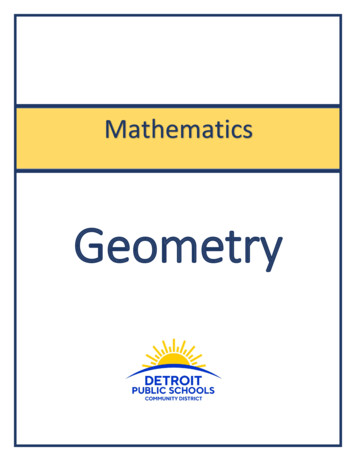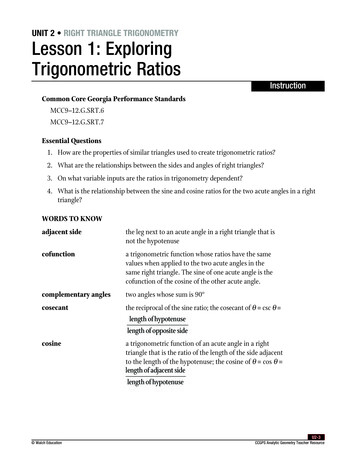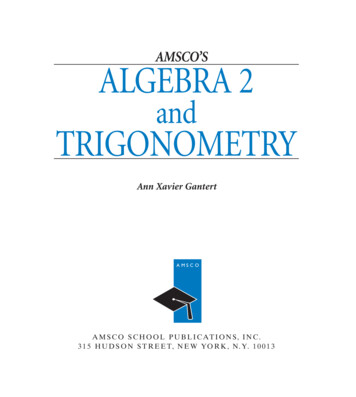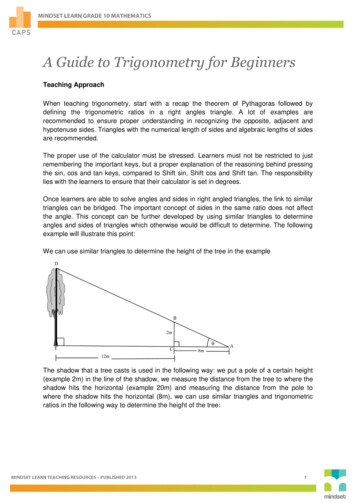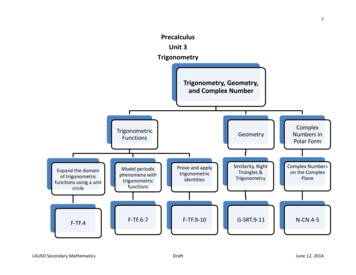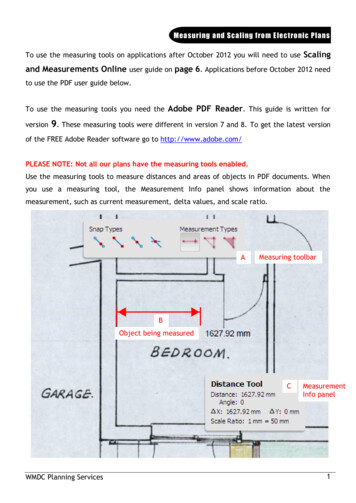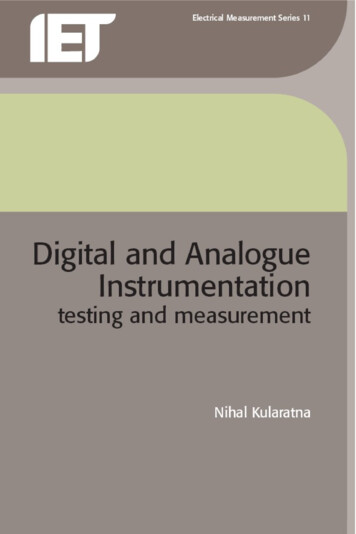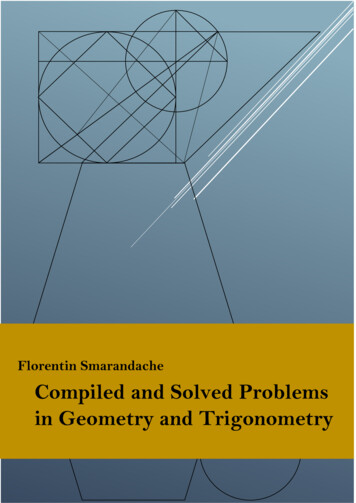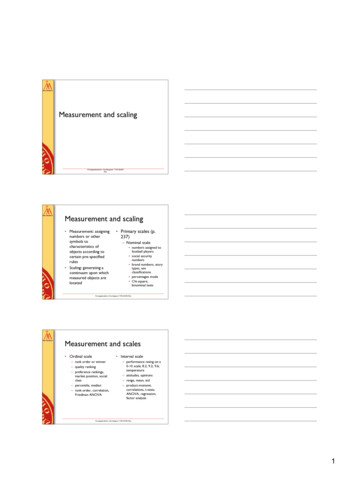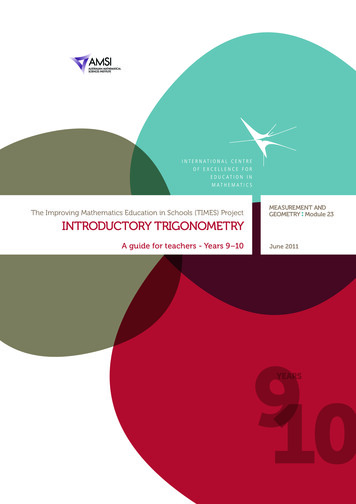
Transcription
The Improving Mathematics Education in Schools (TIMES) Project EASUREMENT ANDMGEOMETRY Module 23INTRODUCTORY TRIGONOMETRYA guide for teachers - Years 9–10June 2011910YEARS
Introductory Trigonometry(Measurement and Geometry: Module 23)For teachers of Primary and Secondary Mathematics510Cover design, Layout design and Typesetting by Claire HoThe Improving Mathematics Education in Schools (TIMES)Project 2009‑2011 was funded by the Australian GovernmentDepartment of Education, Employment and WorkplaceRelations.The views expressed here are those of the author and do notnecessarily represent the views of the Australian GovernmentDepartment of Education, Employment and WorkplaceRelations. The University of Melbourne on behalf of the internationalCentre of Excellence for Education in Mathematics (ICE‑EM),the education division of the Australian MathematicalSciences Institute (AMSI), 2010 (except where otherwiseindicated). This work is licensed under the CreativeCommons Attribution-NonCommercial-NoDerivs 3.0Unported nd/3.0/
The Improving Mathematics Education in Schools (TIMES) ProjectMEASUREMENT ANDGEOMETRY Module 23INTRODUCTORY TRIGONOMETRYA guide for teachers - Years 9–10June 2011Peter BrownMichael EvansDavid HuntJanine McIntoshBill PenderJacqui Ramagge910YEARS
{4}A guide for teachersINTRODUCTORYTRIGONOMETRYASSUMED KNOWLEDGE Familiarity with Pythagoras’ theorem. Basic knowledge of congruence and similarity of triangles. Knowledge of the basic properties of triangles, squares and rectangles. Facility with simple algebra and equations. Familiarity with the use of a calculator.MOTIVATIONThe word trigonometry signifies the measurement of triangles and is concerned with thestudy of the relationships between the sides and angles in a triangle. We initially restrictour attention to right-angled triangles.Trigonometry was originally developed to solve problems related to astronomy, butsoon found applications to navigation and a wide range of other areas. It is of greatpractical importance to builders, architects, surveyors and engineers and has manyother applications.Suppose we lean a ladder against a vertical wall. By moving the ladder closer to thewall, thereby increasing the angle between the ladder and the ground, we increase thedistance up the wall that the ladder can reach. Since the length of the ladder remains thesame, Pythagoras’ theorem relates the distance up the wall to the distance of the ladderfrom the base of the wall. Trigonometry allows us to relate that same distance to the anglebetween the ladder and the ground.
The Improving Mathematics Education in Schools (TIMES) ProjectTo measure the height of a flagpole, an observer can measure a distance out from thebase and the angle made between the top of the pole and observer’s eye as shown inthe diagram.Top offlagpoleAs with many topics in Mathematics, trigonometry is a subject which continues on intothe senior years of secondary school and well beyond into higher mathematics. Moderntelecommunications depend on an understanding and harnessing of signal processing,which is modelled by the trigonometric functions.Each right-angled triangle contains a right angle. The congruence tests tell us thatif either of the following pieces of information is known, then the triangle iscompletely determined: one other angle and one side (by the ASA congruence test) two sides (by either the SAS test or the RHS test).Trigonometry and Pythagoras’ theorem enable us to find the remaining sides and anglesin both cases.{5}
{6}A guide for teachersCONTENTIf we have two similar right-angled triangles (sometimes called right triangles), then theangles of one match up with the angles of the other and their matching sides are in thesame ratio.For example, the following triangles are similar.B‘B5A1084A‘C36C‘Since the matching sides are in the same ratio,BCB C ABA B 1 2.This means that the ratioBCAB 8B C 10A B 4ACAB A C A B 610 BCAC B C A C 86 43 . 5.Similarly, the ratioand35That is, once the angles of a triangle are fixed, the ratios of the sides of the triangle areconstant. In a right-angled triangle, we only need to know one other angle and then theangle sum of a triangle gives us the third angle. Hence, in a right-angled triangle, if weknow one other angle, then the ratios of the sides of the triangle are constant.This is the basis of trigonometry.
The Improving Mathematics Education in Schools (TIMES) Project{7}EXERCISE 1Draw up an angle of 58 using a protractor. Place markers at distances of 3cm, 5cm and8cm and draw perpendiculars as shown in the diagram.h3h2h1O58 538Measure the heights marked, h1, h2, h3 and calculate to one decimal place the ratiosh13,h25,h38Why are the ratios (approximately) equal ?Naming the sidesIn order to distinguish the various possible ratios in a right-angled triangle, we introducesome names. We always refer to the longest side (opposite the right-angle) as thehypotenuse.We now choose one of the two acute angles and label it, often using one of the Greekletters a, , g or . We shall call this angle the reference angle.The side opposite the reference angle is called the opposite side, generally referred to asthe opposite, and the remaining side is called the adjacent side, or simply adjacent, sinceit is next to the reference angle.ChypotenuseBoppositeadjacentA.
{8}A guide for teachersTHE TANGENT RATIOAs mentioned above, once we fix the size of the reference angle in a right-angled trianglethen the ratios of various sides remain the same irrespective of the size of the triangle.There are six possible trigonometric ratios we could use. We mainly work with just threeof them. The remaining three are their reciprocals.The ratio of the opposite to the adjacent is known as the tangent ratio or the tangent of theangle . (The name comes from an earlier time and involves the use of circles.) We writetan oppositeadjacentwhere 0 90 .oppositeadjacentEXAMPLEWrite down the value of tan .ab94026104124SOLUTIONa tan 409b tan 2410125EXERCISE 2By drawing an appropriate triangle explain why tan 45 1hhhFrom the first exercise above, you will have found that the ratios 31 , 52 , 83 were allapproximately 1.6. These ratios correspond to a tangent ratio, so tan 58 is approximately1.6. The calculator gives tan 58 1.6000334529.The tangent ratio for other angles can be found using a calculator. Needless to say thecalculator does not ‘draw a triangle’ but uses clever mathematical algorithms to find thevalue. It is important that students make sure their calculator is in degree mode.We can use the tangent ratio to calculate missing sides in a right-angled triangle, providedwe are given the right information.
The Improving Mathematics Education in Schools (TIMES) ProjectEXAMPLEa Find the length marked x in the diagrambelow, correct to two decimal places.b Find x, correct to two decimal places33 13cm11cm43 x cmx cmSOLUTIONatan 33 Hencex13bx 13 tan 33 tan 43 Hence 8.4411xx tan 43 11sox 11tan 43 11.80THE THREE BASIC TRIGONOMETRIC RATIOSIn addition to the tangent ratio, there are two other basic ratios that we use.These are known as the sine and cosine ratios. We take to be the reference angleso 0 90 . The three ratios are defined by:sin oppositehypotenuse ,cos adjacent,hypotenusetan oppositeadjacentStudents need to learn these definitions thoroughly. One simple mnemonic that mightassist them is SOH CAH TOA, consisting of the first letter of each ratio and the first letterof the sides making up that ratio.EXAMPLEFor the following triangle, write down the value of:a sin b cos c tan 26cm10cm24cmSOLUTIONasin oppositehypotenuse1026513bcos adjacenthypotenuse24261213c tan oppositeadjacent1024512{9}
{10}A guide for teachersSPECIAL ANGLESThe angles 30 , 45 and 60 appear frequently in trigonometry and their sine, cosine andtangent ratios can be expressed using rational numbers and surds.EXERCISE 3In the diagrams below, calculate all sides and angles and then fill in the table below.2211230 45 60 sin cos tan We can use the trigonometric ratios to calculate missing sides in a right-angled triangle.EXAMPLEFind the value of x, correct to four decimal places.ab16 x cm12cm9cm25 c8cm35 x cmx cm
The Improving Mathematics Education in Schools (TIMES) ProjectSOLUTIONa This problem involves opposite andhypotenuse, so use sine.b This problem involves adjacent andhypotenuse, so use cosine.12xsin 25 cos 16 x sin 25 129xx cos 16 9129x sin 25 x cos 16 28.3944 9.3627c This problem involves adjacent and opposite, so use tangent.tan 35 8xorx tan 35 8x x8 tan 55 (55 is the complement of 35 )x tan 55 11.42528tan 35 11.425255 8cm35 x cmEXERCISE 4Suppose that 0 90 .a Explain why sin (90 – ) cos , and simplify cos (90 – ).b Prove thatsin cos tan .c It is standard notation to write (sin )2 as sin2 , and (cos )2 as cos2 .Prove that cos2 sin2 1.d Explain why 0 cos 1 and 0 sin 1.FINDING ANGLESWe have seen that in any right-angled triangle with reference angle , there are three basicratios associated with that angle and that the value of each ratio can be found using acalculator. In order to use the trigonometric ratios to find angles in a right-angled triangle,we need to reverse the process. Thus, given the sine, cosine or tangent of some anglebetween 0 and 90 degrees, we want to find the angle with the given ratio.We have seen that tan 45 1. We say that the inverse tangent of 1 is 45 . This is writtenas tan-1 1 45 .Students must not confuse this –1 index with its usual algebraic meaning of ‘one over’.To help avoid this, it is best to read the symbol tan-1 as inverse tangent and not as tan tothe minus one.{11}
{12}A guide for teachersSimilarly, since sin 30 0.5, we write sin-1 0.5 30 and say: the inverse sine of 0.5 is 30 .To find, for example, cos-1 0.25, we use the calculator, which gives 75.52 , correct to twodecimal places.EXAMPLEFind each of the following, correct to the nearest degree.a sin-1 0.6b cos-1 0.412d the angle for which sin 0.8c tan-1 2e the angle for which cos 0.2SOLUTIONBy calculator.a-1sin 0.6 36.86989. b-1cos 0.412 65.66946. 37 ctan-1 2 63.43494. 66 d 63 If sin 0.8then sin-1 0.8 53.13. 53 e If cos 0.2then cos-1 0.2 78.463. 78 The following exercise shows us how to find an angle from two given sides.EXERCISE 5a Find the angle between the diagonal andthe base of the rectangle, correct to thenearest degree.4cm7cmb Find the base angle in the isosceles triangle,correct to the nearest degree.7cm7cm10cm
The Improving Mathematics Education in Schools (TIMES) ProjectANGLES OF ELEVATION AND DEPRESSIONWhen an observer looks at an object that is higher than the (eye of) the observer, theangle between the line of sight and the horizontal is called the angle of elevation.On the other hand, when the object is lower than the observer, the angle between thehorizontal and the line of sight is called the angle of depression. These angles are alwaysmeasured from the horizontal.objectline of sightangle of elevationhorizontalhorizontalangle of depressionline of sightobjectEXAMPLEFrom the top of a cliff, 100 m above sea level, the angle of depression to a ship sailing pastis 17 . How far is the ship from the base of the cliff, to the nearest metre?SOLUTIONThe diagram shows the top of the cliff P, the ship S and the base of the cliff B.Let SB x m be the distance of the ship from the cliff. By alternate angles, PSB 17 .Hencesotan 17 x P100x17 100tan 17 327.085100mS17 xmThe distance is 327 m (to the nearest metre).In some problems several steps may be required to find the desired lengths.B{13}
{14}A guide for teachersEXAMPLEFrom a point A, 10 m from the base of a tree, the angle of elevation of the top of a tree is36 . From a point B, x m further on from the base of the tree, the angle of elevation is 20 .a Find the height of the tree to the nearest tenth of a metre.b Find the distance x m to the nearest tenth of a metre.SOLUTIONHhm36 10mO20 BxmAa Let the height of the tree be h metresIn OHA,tan 36 soh10h 10 tan 36 7.2654. 7.3 m, to the nearest tenth of a metreNote: The approximation 7.3 is not used in part b. It leads to the wrong answer.b In HOB,hOB tan 20 henceOB htan 20 10 tan 36 tan 20 19.96.sox AB OB – OA 9.96. 10.0 m to the nearest tenth of a metreEXERCISE 6EConsider the diagram shown opposite.1a Prove that BD 2 (AD CD).b Hence deduce thattan DEB 12 tan AED 12 tanA CEDBCD
The Improving Mathematics Education in Schools (TIMES) Project{15}TRUE BEARINGSOne of the early applications of trigonometry was to improve navigation. Bearingsare used to indicate the direction of an object (perhaps a ship) from a fixed referencepoint (perhaps a light house). True bearings give the angle from the north measuredclockwise. We write the true bearing of as T, where is an angle between 0 and360 . It is customary to write the angle using three digits, so 0 T is written as 000 T,and a true bearing of 15 is written as 015 T.We can use trigonometry to solve problems involving bearings.EXAMPLEAnthony walks for 490 metres on a bearing of 140 T from point A to point B.Find to the nearest metre,a how far east the point B is from the point A.b how far south the point B is from the point A.NSOLUTIONa Distance east 490 sin 40 315 m (correct to the nearest metre)b Distance south 490 cos 40 A140 40 375 m (correct to the nearest metre)490mBCOMPASS BEARINGSNavigational questions can also be given using compass bearings.EXERCISE 7From a point P, a ship sails N 20 E for 20km to the point Q. From Q the ship sails N 70 Wuntil it is at the point R directly north of P. Find the distance PR.AREA OF A TRIANGLEIf we take any triangle with two given sides a and b about a given (acute) angle , then thearea of the triangle is given by1Area 2 ab sin
{16}A guide for teachersEXERCISE 8By dropping an altitude in the triangle shown below, derive the formula stated above.BacACbNote that the above formula works even in the case when is obtuse. In the module,Further Trigonometry, we will show how to define the sine of an obtuse angle.LINKS FORWARDSINE AND COSINE RULESFrom the material developed so far it should be apparent that the trigonometric ratios area powerful tool for relating angles and sides in right-angled triangles. Not all triangles, ofcourse, possess a right angle. We can extend the angle/side connection to an arbitrarytriangle using two basic formulas known as the sine rule and the cosine rule.The sine rule states that in the triangle shown,CabAasin A bsin B c.sin CBcIn words this says that in any triangle, any side divided by the sine of the opposite angle isequal to any other side divided by the sine of its opposite angle.The cosine rule states that in the triangle shownAcbCac2 a2 b2 – 2ab cos C.BThis may be thought of as Pythagoras’ theorem with a correction term.You may care to derive these from the material established in this module. The sine ruleis relatively easy to prove. For the cosine rule, drop a perpendicular from A and applyPythagoras’ theorem to the two triangles. The details of the proofs are given in themodule, Further Trigonometry and in the module, Pythagoras’ Theorem.
The Improving Mathematics Education in Schools (TIMES) ProjectOBTUSE ANGLESIn general, a triangle may contain an obtuse angle as well as acute angles. Thus far wehave only defined the trigonometric ratios for acute angles.The trigonometric ratios can be extended to include obtuse angles and this will be donein the module, Further Trigonometry.If is an obtuse angle then the sine of is given bysin sin (180 – ).Note that if is an obtuse angle, then its supplement, 180 – , is acute.Similarly, if is an obtuse angle then the cosine of is given bycos – cos (180 – ),and the tangent of is given bytan – tan (180 – ).Thus, the sine of an obtuse angle equals the sine of its supplement and the cosineand tangent of an obtuse angle equal the negative of the cosine and tangent of itssupplement, respectively.In the module, The Trigonometric Functions we extend the definitions even further toinclude all angles, including those greater than 180 and negative angles.Once we are able to find the sine of all possible angles, we can plot the graph of thefunction y sin x. This leads us to study the trigonometric functions which are used todescribe wave motion and electronic signal processing.THE RECIPROCAL RATIOSThere are six possible ratios that one might take between the three sides of a right-angledtriangle. We can take the reciprocal of the three ratios sine, cosine and tangent to producethe remaining three.These ratios are called: cosecant, secant and cotangent respectively. These are written ascosec , sec , and cot .Thus, if 0 90 ,cosec hypotenuseopposite 1sin ,sec hypotenuseadjacent 1cos ,cot adjacentopposite 1tan The prefix co- is short for complementary, since the cosine of an angle is equal to thesine of its complement. The cotangent of an angle is the tangent of its complement andsimilarly the cosecant of an angle is the secant of its complement.{17}
{18}A guide for teachersWe saw in the examples in this module, that we can get by with using only the sine,cosine and tangent ratios in problem solving. However, the reciprocal ratios arise naturallywhen we study the calculus of the trigonometric functions.EXERCISE 9Show that, if 0 90 ,a 1 tan2 sec2 .bcot2 1 cosec2 .HISTORYBABYLONIANSThe Plimpton 322 tablet, believed to have been written about 1800BC, contains a table ofnumbers in base 60 that are believed by some to be an early record of tangent ratios. Thisremains controversial.THE GREEKSThe Greeks developed a form of trigonometry based on chords in a circle. Hipparchus ofNicaea (c. 180-125 BC), sometimes called the father of Trigonometry’, came from nearpresent day Istanbul. He was an astronomer and he was able to calculate the duration ofthe year to within 6 minutes. To assist with his astronomical calculations, he developed anearly form of trigonometry and drew up tables of chords. This table was later extended,and used, by Ptolemy (c.90–160 AD).Hipparchus divided the circumference of a circle into 360 (as the Babylonians had done)and the diameter into 120 parts.Then for a given arc AB subtending an angle a at the centre, he gives the length of thecorresponding chord crd(a), as shown in the diagrams below.ARcrd ( ) ABORB
The Improving Mathematics Education in Schools (TIMES) ProjectNote then that crd (60 ) R and also crd (90 ) 2R.The length of the chord is related to the sine ratio as the following diagram shows.ARO2RBaAB crd(a) 2R sin 2 .Hipparchus did his calculations with R 60. Algebraic notation was not available at this time.INDIANS AND ARABSWith the decline of civilisation in the West, Indian and Arab mathematicians built on thework of the Greeks. In about the 5th century AD, in a work known as Surya Siddhanta,a table of sines appeared. The Arabs also developed spherical trigonometry, again to beused in astronomy.As we saw above, the sine is related to half a chord, and the word sine itself, arosefrom a series of mistranslations of a Sanskrit word for half-chord. The Indian word wastransliterated into Arabic and then misunderstood as a word meaning breast. This in turncame to mean curve and hence bay or gulf which is sinus in Latin.REGIOMONTANUSThe motivation for much of early trigonometry was astronomy. The first puretrigonometrical text written in Europe was De triangulis Omnimodis (‘On all sorts oftriangles’) by Johann Müller (1436 – 1476), alias Regiomontanus. His work was motivatedby his translation of Ptolemy, in which he realised that a more systematic treatment oftrigonometry was required. He wrote:You who wish to study such great and wonderful things, who wonder at themovement of the stars, must (first) read these theorems about triangles!In his work, he derives and proves the sine rule.{19}
{20}A guide for teachersLATER DEVELOPMENTSThe cosine was defined by cos sin (90 – ). This is the sine of the complement ofthe angle.The terms tangent and secant were introduced by T. Fink (1561 – 1656) while cotangent,(the complement of the tangent), was introduced by by E. Gunther (1581 –1626).The following diagram shows how the names tangent and secant arose:BsectanAOAB tan a, OB sec a.1If the radius of the circle is 1, then AB, which has length tan a, touches the circle at A(Latin tango – I touch) and OB, which has length sec a, cuts the circle (Latin seco – I cut.)ANSWERS TO EXERCISESEXERCISE 1The right-angled triangles are similar to each other.EXERCISE 2Draw a right-angled isosceles triangle. The equal angles are each 45 .Therefore tan 45 1.EXERCISE 3 30 45 60 sin 121232cos 321212tan 1313
The Improving Mathematics Education in Schools (TIMES) ProjectEXERCISE 4a, b and c are the side lengths of triangle ABC. C 90 and A .a sin acand cos B c . But B 90 – . Therefore cos (90 – ) sin .b tan ab 2aac2c sin cos bca2c2 sin cos b2c2 a2 b2c2 1d The hypotenuse is the longest side and so sin EXERCISE 5a 30 b 44 EXERCISE 6aBD AD – ABBD BC CDAdding gives 2BD AD CD1BD 2 (AD CD)btan DEB BDEDAD CD2ED12tan AED 12tan CEDEXERCISE 721.28 kmEXERCISE 8Draw BD perpendicular to AC with D on AC.121 2Area b BDab sin EXERCISE 9sin2 cos2 1a Divide both sides by cos2 to obtain the result.b Divide both sides by sin2 to obtain the resultac 1 and cos bc 1.{21}
The aim of the International Centre of Excellence forEducation in Mathematics (ICE-EM) is to strengtheneducation in the mathematical sciences at all levelsfrom school to advanced research and contemporaryapplications in industry and commerce.ICE-EM is the education division of the AustralianMathematical Sciences Institute, a consortium of27 university mathematics departments, CSIROMathematical and Information Sciences, the AustralianBureau of Statistics, the Australian Mathematical Societyand the Australian Mathematics Trust.The ICE-EM modules are part of The ImprovingMathematics Education in Schools (TIMES) Project.The modules are organised under the strandtitles of the Australian Curriculum: Number and Algebra Measurement and Geometry Statistics and ProbabilityThe modules are written for teachers. Each modulecontains a discussion of a component of themathematics curriculum up to the end of Year 10.www.amsi.org.au
2 h 3 Measure the heights marked, h 1, h 2, h 3 and calculate to one decimal place the ratios h 1 3, h 2 5, h 3 8. Why are the ratios (approximately) equal ? Naming the sides In order to distinguish the various possible ratios in a right‑angled triangle, we introduce some names. We always refer to the longest side (opposite the right‑angle .
